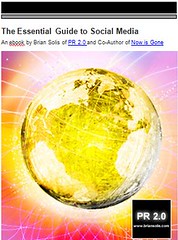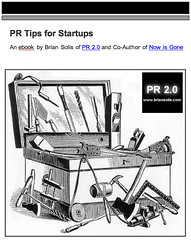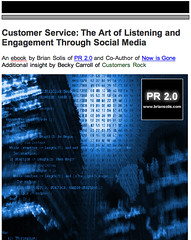Deleting Users, Audience, and Messages from PR and Social Media

Attention PR and practicing Social Media professionals, step away from using "messages" to target "users" and "audience." They are no longer filling the theaters, stadiums, and auditoriums to hear from marketers.
I've been in tech PR since 91 and have been also guilty of using such terminology. Back in the day, users really were users in the tech business and when we were researching who they were, they would ultimately become the audience for our marketing initatives. Not everyone (aka potential customers) was tech savvy at the time, so referring to "people" just didn't cut it. And, it was never intended to be naive nor deragatory, it simply was a specific and effective category.
Fast forward to 2007 where the net reaches over 80% of the U.S. population, we now find that users are a series of collective groups of people across different walks of life. But please, don't call them "users" or your target "audience," because they are also the people formerly known as the audience.
Josh Bernoff of Forrester recently wrote a great post on the subject where he declared, "I'm sick of users...The more I write and read about social media, the more frustrated I get with the term 'users.'"
The web sparked a revolution in PR which set the stage for an overdue shift in how PR pros approach marketing. Now in the dawn of Social Media, PR has no choice but to embrace something it resisted for far too long, transparency and participation.
Discussing marketing in terms of audience and users implies a one to many approach, whereas focusing on people begets a one to one communications strategy - shifting from monologue to dialog.
But it's much more powerful than simply focusing on individuals. We can expand out focus to reach different groups of people that are linked by common interests.
When we look at groups of people respectively, we're forced change our migration path to them. Each group is influenced, inspired and driven by unique channels and communities. Figuring out who we want to reach, why they matter to us, and why we matter to them, is the ante in order to buy into this game. Then we reverse engineer this process of where they go for their information and discussions to learn about how to reach them. And, while there may be several horizontal mediums that overlap, the vertical avenues are dedicated.
And while we're deleting words from our vocabulary. Let's go ahead and eradicate "messages" when discussing customers and people. They don't want to hear messages, they want to hear how you can help them do something better than how they do it today or how this is something that they couldn't do before, taking into specific account, their daily regime.
Messages are not conversations and there is no market for them.
Here's an example:
Hi, my name is Brian and I’m an innovative, visionary and captivating person who is trying to revolutionize the world of communications so that the industry can monitor the evolutionary paradigm shift occurring as the democratization of information and user generated content spans across the chasm, while riding the cluetrain, influencing early adopters, energizing the market majority and the engaging the global microcommunities that define the long tail in this Web 2.0 world.
Ugh. Let's move on, quickly.
Ok, so the next step is to listen and read before you engage. There's much to learn about each of the conversations, information and communities you wish to jump into. You'll find that more often than not, you'll change your story based on the insight garnered from simply observing. It's the difference between speaking in messages and relevance.
This entire process is invaluable to the new world of marketing, traditional and social media alike. It forces PR to think like a customer instead of competitor or a marketer.
Update: Doc Searls includes a portion of this post as part of his a "Quote du jour" series and includes a link to an article he wrote in 1998 for Web Informant entitled, "There is no demand for messages."
Connect on Twitter, Jaiku, Pownce or Facebook.
pr2.0 pr 2.0 pr+2.0 public relations public+relations media+2.0 media media2.0 marketing audience users terminology socialmedia social+media












9 Comments:
What do you think about the term "publics" which since early 20th century indicated groups just as you describe who come together around issues and common interests?
I also take the point about not thinking in messages - but conversations still involve discussing something based on opinions, information, etc. How do we encapsulate that?
Heather, appreciate you bringing up these points.
Publics is one way to capture it - it would definitely need some marketing around it...insert said term to address the people you're trying to reach and it will work, it's the intent that counts IMHO.
re: messages, I think you captured it correctly by defining what's involved in conversations (except I'd add relevance.) They're distinct. Conversations are not messages and messages are not conversations.
You aren't the first guy to say this and I'm not trying to insult you, but can you or any of the other people who are dissatisfied with the terminology we're using today come up with some valid replacements? All I'm reading from this article is whining, which is good, but people pay more attention to the guy who brings a solution to the table.
Hi Stefan, interesting perspective here. I think the more people that not only say this, but practice it, is what it will take to make a real shift here.
And not sure where you're reading anything close to whining. It's a pretty progressively written piece that talks about what was and also recommends new ways to approach this subject. I even use examples.
In terms of valid replacements...I'm trying to step back from labels to open our the discussion.
When we look at "groups" of people respectively, we're forced to change our migration path to them. Each group is influenced, inspired and driven by unique channels and communities.
Figuring out who we want to reach, why they matter to us, and why we matter to them, is the ante in order to buy into this game. Then we reverse engineer this process of where they go for their information and discussions to learn about how to reach them.
Others have recommended customers and buyers too..but that dehumanizes the process. Maybe it's as simple as defining the groups of people you want to reach.
Hey, Brian,
You've rung my chimes with this one.
When I start hearing hackneyed labels applied to anything, they first lose their impact and then the writer or speaker loses my respect.
We see so many calls for "authenticity"--then experience the opposite with canned labels and phrases.
Maybe it's just me, but I really enjoy the flow of everyday conversation using everyday language, regardless of the topic or scenario.
Keep writing...
I coined the term "Interaction Network" a while back to define a group that which becomes the new term after "Social Networks" because once you have commerce, media etc... defining measurable interaction between groups that can be directly targeted it's no longer "social".
I use the term Interaction Network because it simply puts into context the influencing people to act or do things within the network. Social Network only defines relationships, Interaction Networks defines how valuable those relationships are in social marketplaces.
I think terms like Social Network hit home with people but people tend to stick to 1 term to cover the whole industry. Social Network's are Web 2.0. The next big thing is Interaction Networks for Web 3.0 and beyond. This is something I have pioneered under Blipd.com.
This comment has been removed by the author.
Great post, however, I do think that some of the commentators have made some good points. We have a 100 years of marketing, PR and scientific management to overcome. Telling stories might be the way to illustrate.
I think that people can understand the concept of advertising. You write an ad, and publish it in a place where potential customers are going to read the ad. That's one-way conversation, the sales pitch, pretty simple for most people to understand. The focus is what the company wants to say, two-way conversation in a business context how does that work?
Perhaps an expert who gives advice with no strings attached. No pitch, no sale, just good credible information that helps you to make a good decision. Yes, the focus is what the customer wants to hear or talk about.
Brian, I appreciate the time you took to write this post and the thoughtfulness you poured into it. I recently wrote a post called "A Blog's Audience" to position some of my thoughts on this issue. My friend passed along this post on your blog, which really helped me delve into the issue deeper. I'm new to blogging as you'll see from my post, but continuing to learn more about this arena that I've stood opposed to for so long. If you have a chance, check it out: stayengaged.blogspot.com
Thanks!
Post a Comment
<< Home